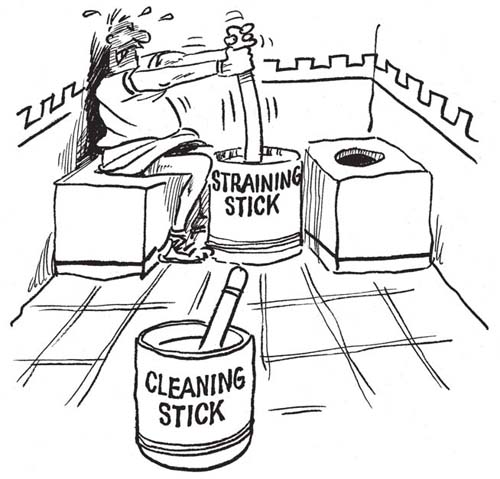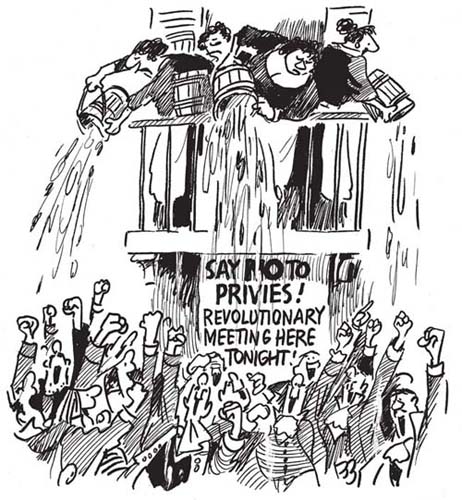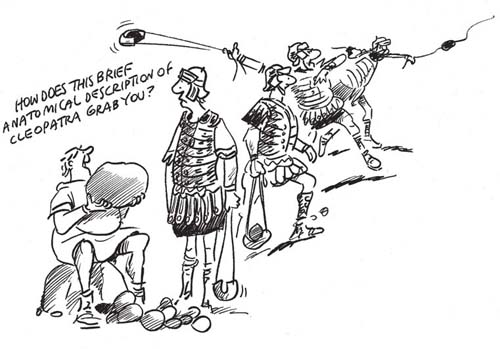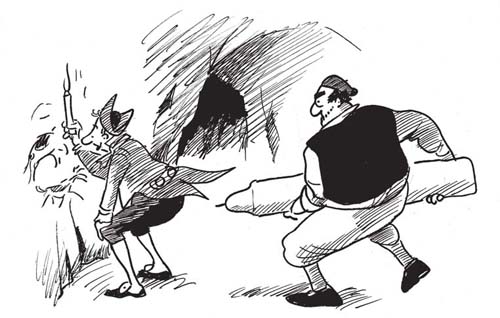Disgraceful Archaeology (11 page)
Read Disgraceful Archaeology Online
Authors: Paul Bahn

51
At the Roman games, women sometimes broke into hysterical spasms — or had orgasms — and not only the commoners in the upper tiers. When one handsome young gladiator, until recently a farmboy from the Apennines, was paraded before the podium with his bloody sword upraised, a great lady screamed uncontrollably and flung her brooch and necklace into the arena. Then she stripped off her rings, threw them onto the sand, and finally ripped off her undergarments and threw them also. When he encountered the crumpled garments, he thought the lady had simply thrown him her scarf or cloak. As he picked up the clothing to toss it back, the underwear unfolded. The simple boy stood gazing horrified at what he was holding. Then he dropped the garments and fled from the arena ‘more terrified of a woman’s underwear than he had been of his enemy’s sword.’ The crowd thought this was killingly funny and nearly died laughing. The patrician lady’s husband, however, was not amused (
51
).
Hippla was a noble lady who left her husband and children and fled to Egypt with a gladiator named Sergius. As Juvenal, the first century poet, says, ‘Sergius was maimed, getting old, had a battered face, his forehead was covered with welts from his helmet, his nose was broken and his eyes were bloodshot. But he was a swordsman!’ Many great ladies enjoyed the company of famous gladiators in their private apartments. At Pompeii, a series of crude sleeping rooms were discovered which turned out to be a gladiators’ dormitory; and there, frozen in time, was a gladiator who was holding in his arms, and no doubt protecting her from the hot ashes, an upper-class woman still wearing her jewels.
In later life, the Roman emperor Augustus was a womanizer, and as an elderly man he is said to have still harboured a passion for deflowering girls — who were collected for him from every quarter, even by his wife!
The Roman emperor Caligula used to invite a selection of married women to dinner with their husbands; he would slowly and carefully examine each in turn; then, whenever he felt so inclined, he would send for whoever pleased him best, and leave the banquet in her company. Later he would return, showing obvious signs of what he had been doing, and openly discuss his bedfellow in detail, dwelling on her good and bad physical points, and criticizing her sexual performance.
The Roman emperor Domitian was extremely lustful, calling his sexual activities ‘bed-wrestling’, like a sport. He preferred to depilate his concubines himself and would go swimming with the commonest of prostitutes.
In ancient Rome, there were public latrines, but no privies attached to houses. There were basins and tubs, which were emptied daily by servants detailed for the purpose. No closet-paper was in use, none having yet been invented or introduced in Europe, but in each public latrine there was a bucket filled with salt water and a stick having a sponge tied to one end, with which the passer-by cleansed his person, and then replaced the stick in the tub (
52
). Seneca describes the suicide of one barbarian captive, a German slave, who rammed one of these sticks down his throat.

52
In the thirteenth century, a Roman bandit Matteo Orsini had the electing cardinals locked up in a small, ruined temple, with no food or water. His soldiers were instructed to urinate and empty their bowels on their Eminences through the holes in the roof until they agreed to nominate the candidate of his choice. But it made conditions so bad in the temple that the new Pope and two of the cardinals died two days after the election.
Before ‘garderobes’ were built corbelled out from castle walls, they were within the thickness of the walls, so that the filth flowed down the outer face of the building into the moat! The King’s privy chamber at Westminster was built on an arch over the water of the Thames — in 1238 the clerk-of-the works was ordered to bar the entrance to this arch with strong iron bars so that no one could enter there!
The records exist of one Henry Ivory, a privy cleaner of fourteenth-century London — he was paid by the number of pipes (one pipe = four barrels) of filth taken away. For 31 pipes he got 51 shillings and 8 pence. The work was probably done at night, with the filth carted to the river where the dung-boats took it away (
53
). In 1281, the cloaca of Newgate Jail had to be cleaned and repaired — thirteen men worked for five nights, cleaning the cesspool, and a breach was made in the stone wall for the filth to be taken out. Four watchmen, hired for four nights, stood at the gap in the wall to prevent prisoners escaping!
In ancient times, the belief was once widely diffused of the power possessed by sorcerers over the unfortunate wretches whose excreta, solid or liquid, fell into their hands. So some scholars think the introduction of latrines and urinals was not for purely hygienic considerations, but also to prevent one’s being open to sorcery by these means.
According to Captain Cook, while the New Zealanders had privies to every three or four of their houses, there were none in Madrid until 1760 — the determination of the Spanish king to introduce them and sewers, and to prohibit the throwing of human ordure out of windows after nightfall, as had been the custom, nearly precipitated a revolution (
54
).

53
Some public cesspools were so big that, when they were cleaned out, they filled 100–120 barrels. The bodies of murdered people were sometimes thrown into these deep wells, because they took several years to be filled, and by the time they were cleaned out the murderer was long gone.
Until the nineteenth century, people often preferred the cool, sparkling waters of city wells to the piped water of the city companies; but the very sparkle of the waters was due to the presence of ammonia and other organic matter in solution — much of this contamination was caused by the frequent pollution of wells by privy filth, and led to outbreaks of cholera and fevers.
The oldest toilet in Japan is of the late seventh century AD, found in 1992 at the Fujiwara Palace site in Nara — it was filled with black mud and
mokkan
, inked wooden tablets used to
record various transactions in the bureaucratic state. There were also lots of fruit seeds, and numerous parasite eggs.

54
The famous dispute between King Richard the Lionheart and the Arch-Duke of Austria, which led to the English monarch being incarcerated in a dungeon, arose from the insult caused when Richard threw the Austrian standard, the Duke’s banner, down a privy.
In medieval London, a ditch in Holborn, next to the inn of the Bishop of Lincoln, was blocked with the entrails of animals, dung, dead dogs, and other putrefying matter. The city moat itself was called Houndsditch because it had often been used as a dumping place for dead dogs!
From the Roman world, there are also lead sling-bullets with things like ‘Get Pompey’ written on them, rather like the ‘love to Saddam’ that was chalked on laser-guided bombs in recent years (
55
).
The graffiti of Pompeii include soldiers and gladiators boasting about their love-lives; there is material about gay sex at the palaestra; there are curses, such as: ‘May your ulcerous pustules
burst open and burn like never before’ (
56
); and Herculaneum has a graffito by a doctor (?) who wrote ‘I had a really good crap here’. Pompeii also has drawings with written graffiti — such as
Fortunata (fellat)
.

55

56
Deep inside the Ice Age decorated cave of Niaux, France, there is a graffito from a century or two ago saying ‘Here at the age of 13 I lost my virginity’ (
57
).
A letter found at Vindolanda fort, near Hadrian’s Wall, sent by a mother to her (doubtless shivering and grateful) soldier son, says ‘I have sent you … woollen socks .… two pairs of sandals and two pairs of underpants.’
It seems the Bronze Age boat found at Dover a few years ago was once saved from sinking by having someone’s underpants shoved in the hole — the ultimate sacrifice.
The excavation of Kingston-upon-Hull’s Augustinian Friary unearthed the shroud burials of six men of 1410–30 who were fashion victims — they were all wearing ‘boxer shorts’, underpants of good-quality wool. This was a new fashion, brought about by the adoption of canvas breeches, which chafed terribly — hence these underpants ‘for chaps’.

